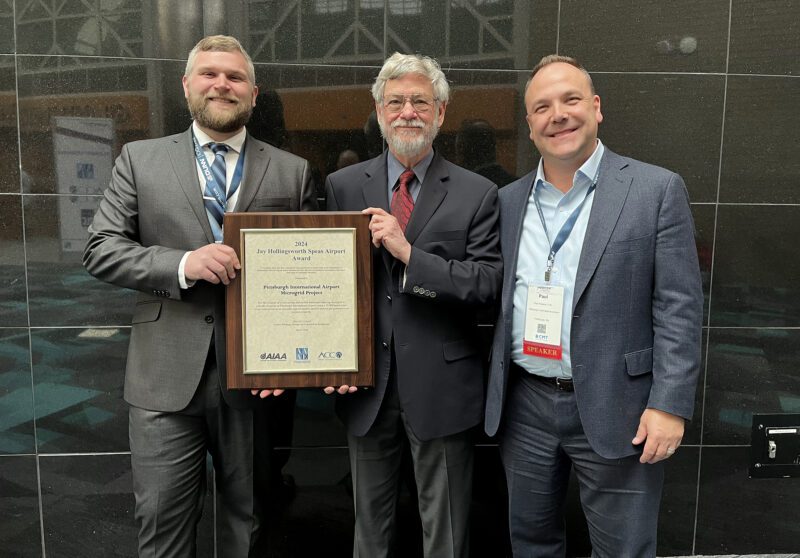PIT’s Microgrid Honored with Another Aviation Award
Prestigious Speas Award recognizes airport’s work in environmental field
By Matt Neistein
Published March 8, 2024
Read Time: 3 mins

The unique microgrid at Pittsburgh International Airport continues to rack up honors.
The most recent came Wednesday at an industry conference in Salt Lake City, where the airport received the prestigious Jay Hollingsworth Speas Award. The award is given annually to people or organizations “judged to have contributed most significantly in recent years to the enhancement of relationships between airports and/or heliports and their surrounding environments via exemplary innovation that might be replicated elsewhere.”
The award was presented by R. Dixon “Dirk” Speas, brother of the late Jay Speas, an engineer employed by Planning Research Corp. who died unexpectedly in 1984 at the age of 33.
The microgrid “has more than paid for itself. In fact, the ROI is virtually infinite since it didn’t cost the airport anything but labor, and they’re saving a million (dollars) or two in annual electricity costs,” Speas told the nearly 2,000 attendees of the AAAE/ACC Airport Planning, Design, and Construction Symposium.
Recent winners of the award, which took a pandemic-caused break for three years, include the airports in Jackson Hole, Wy.; Louisville, Ky.; and Nashville.
John Bevilacqua, an electrical engineer at PIT, then gave a presentation on the airport’s microgrid, composed of nearly 10,000 solar panels and five generators fueled by natural gas drilled on the property. The microgrid powers the entire airfield, both terminals, the Hyatt hotel and the Sunoco gas station.
The award comes with a $7,500 cash prize and a framed certificate.

From left, John Bevilacqua, PIT Electrical Engineer; R. Dixon “Dirk” Speas; and Paul Hoback, PIT Executive Vice President and Chief Development Officer, pose with the Jay Hollingsworth Speas Award on March 6 in Salt Lake City, Utah. (Photo by Matt Neistein)
PIT Leading the Way on Energy
“I’m very happy with where we are. The microgrid has been very reliable,” said Tom Woodrow, Senior Vice President of Engineering and Intelligent Infrastructure. “It saved us a lot of money, and it’s certainly helping us to meet our sustainability goals—providing both an economic and environmental benefit while increasing resiliency.”
First unveiled in July 2021, the microgrid is the first in the world to completely power a major airport through on-site natural gas and solar energy. The microgrid allows PIT to be self-sufficient for power generation and resistant to outages on the traditional grid.
PIT’s microgrid can produce up to 23 megawatts between its five natural gas-fired generators and solar panels. The solar array is built atop a closed landfill, repurposing land that is otherwise unsuitable for development initiatives and underscoring the airport’s sustainability goals.
The microgrid has saved approximately $1 million annually in utility costs while reducing carbon emissions by more than 6 million pounds per year.
Other airports are developing similar projects for themselves. A team from Houston’s George Bush Intercontinental Airport has visited PIT for a tour and is in the early stages of planning a power generation and resiliency strategy. Officials at John F. Kennedy International Airport announced last year the future New Terminal One will be powered by more than 13,000 solar panels as well as natural gas fuel cells as part of its 11.3-megawatt microgrid.
Woodrow said the airport is planning to double the number of solar panels as part of its solar field expansion.
PIT’s microgrid has gotten its share of attention and won multiple awards for its innovation and sustainability. Among them: Forbes magazine called PIT’s microgrid “tough to duplicate,” and it has been recognized with the Innovation Award from Airports Council International and Fast Company Magazine’s World Changing Idea award.






